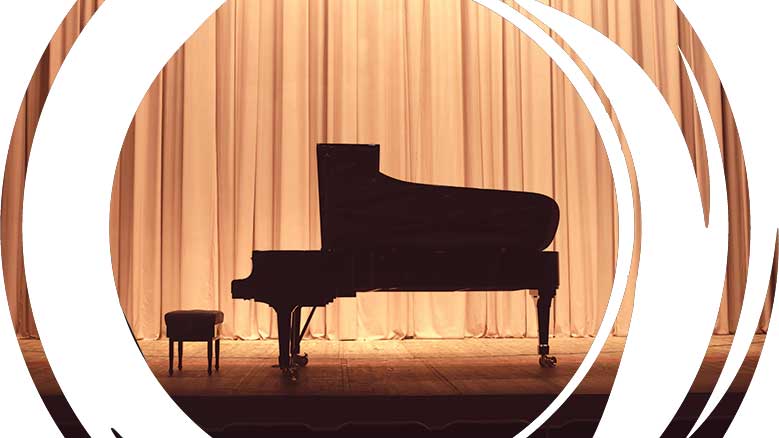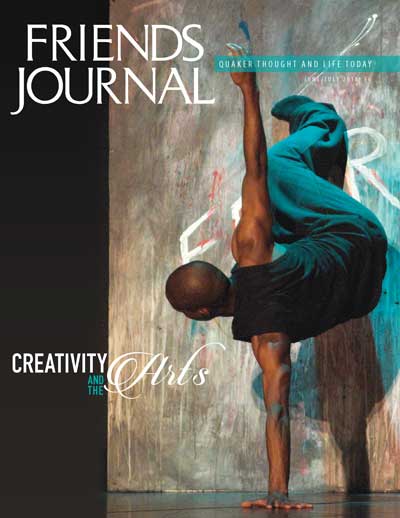
I am a Quaker. I am also a musician. As a Quaker, I think a lot about silence. As a musician, I also think a lot about sound. Negotiating the worlds of silence and sound is the essence of my livelihood and my spiritual life.
Quakers are of course known for gathering in silence for our meetings for worship. We are careful to point out to those of other faiths that we do not “worship silence,” nor is our silence to be confused with individual meditation. Rather, we meet in communal silence to experience an encounter with God, the Light, Spirit, the Inner Teacher together. As Ohio Valley Yearly Meeting’s Faith and Practice explains:
Gathering in an outward silence is not enough. Each individual must consciously and earnestly seek in humble reverence for a renewed sense of the inward power of the Spirit. From the depths of that stillness comes the consciousness of the presence of God. In this experience individuals will not only find direction for their lives and strength for their needs but will also feel an urge to share with others the openings that have come to them. As the worshippers seek to be led to deeper understanding and pray to become more obedient to the Christ within, their shared communion with the Divine will release to all in the meeting the riches of the Spirit.
In preparing for worship and ministry, Ohio Valley Yearly Meeting further advises:
Frequent periods of private retirement, meditation, reading the Bible or other inspirational texts, prayer, and appreciation of beauty and nature are recommended as preparation for the meeting hour. To awaken and sustain the spirit of worship, both teaching and prophetic vocal ministry are valuable. Spiritual sensitivity must be the first requirement for this ministry. Constant openness to be guided by the Inward Light and a commitment to live with integrity are preparation for ministry, as are thoughtful meditation on the importance of this opportunity and a sincere dedication to the purposes of God.
This piece has entered the pop culture lexicon as a kind of conceptual prank: who ever heard of a piece of music in which no notes are played?
References to quieting oneself and opening oneself remind me of a quote often related by the American composer John Cage (1912–1992). He asked the Indian classical musician Gita Sarabhai about was the function of music. Her response was, “To sober and quiet the mind, thus rendering it susceptible to divine influences.” As recounted in David Revill’s biography, Cage later told an interviewer:
I was tremendously struck by this, and then something really extraordinary happened. [Fellow composer] Lou Harrison, who had been doing research on early English music, came across a statement by the seventeenth-century English composer Thomas Mace expressing the same idea in almost exactly the same words. I decided then and there that this was indeed the proper purpose of music.

John Cage is perhaps best known for his famous “silent” piece of music, 4′33″. Since its premiere by pianist David Tudor in 1952, the piece has become one of the most controversial pieces of the twentieth century. In this piece, the performer makes no sound. This piece has entered the pop culture lexicon as a kind of conceptual prank: who ever heard of a piece of music in which no notes are played? But Cage’s composition was eminently serious.
Cage often remarked that in his music “nothing takes place but sounds: those that are notated and those that are not.” In his influential book Silence, Cage notes, “There is always something to see, something to hear. In fact, try as we may to make a silence, we cannot.” In support of this statement, he was fond of sharing a story of his visit to an anechoic chamber, a room designed to be as silent as possible, at Harvard University:
I entered. . . and heard two sounds, one high and one low. When I described them to the engineer in charge, he informed me that the high one was my nervous system in operation, the low one my blood in circulation. Until I die there will be sounds. And they will continue following my death. One need not fear about the future of music.
Cage’s 4’33” has its origins in an idea that he shared in a 1948 lecture at Vassar College, in which he describes two works in progress, one of which was “a piece of uninterrupted silence”:
It will be three or four-and-a-half minutes long . . . and its title will be “Silent Prayer.” It will open with a single idea which I will attempt to make as seductive as the color and shape or fragrance of a flower. The ending will approach imperceptibly.
While many of the details he shares about this piece-in-progress are elusive, its original title of “Silent Prayer” should resonate with the experience of Friends.
In later describing the first performance of the piece, Cage told an interviewer,
What they thought was silence, because they didn’t know how to listen, was full of accidental sounds. You could hear the wind stirring outside during the first movement. During the second, raindrops began pattering the roof, and during the third the people themselves made all kinds of interesting sounds as they talked or walked out.
Indeed, the piece consists of sounds that are “not notated”—sounds in the environment. Someone who is aware of this when listening to a performance of 4’33” would be in effect listening intently for those sounds. This listening practice is similar to the work of Cage’s contemporary, composer Pauline Oliveros (1932–2016), who pioneered a practice she called “deep listening.” Oliveros defined deep listening as “listening in every possible way to everything possible to hear no matter what one is doing.” When listening in every possible way to Spirit no matter what one is doing, the silence would not be bothersome (as it was to Cage’s audience), or puzzling (as the first experience of our meetings for worship sometimes is for visitors). It would, in fact, not be silence.
I open myself to await those messages of ministry, in much the same way that I listen for the sounds of my surroundings in a performance of 4’33”
In my experience, our meeting for worship is also not really silence; it is a deepening of our listening together, not for the aesthetic experience of listening to sounds from the environment but for awaiting the messages of vocal ministry. What is the experience of “silent” Quaker worship, if not expectantly waiting for messages of ministry from the Inner Teacher?
This is not to suggest that every Friends worship service is a performance of 4’33”. But in settling in at the beginning of a meeting for worship, I open myself to await those messages of ministry, in much the same way that I listen for the sounds of my surroundings in a performance of 4’33”. I await these messages from the Light with the following prayer:
Open my ears to silence.
Open my heart to healing.
Open my mind to insight.
Open my soul to love.
Open my eyes to beauty.
Open my spirit to joy.
Open my actions to peace.




Dear Kevin, Thank you for your reflections on the similarities between Cage’s work and the silence in our meetings. This is also something I have thought a lot about – I am a Member of the Hague MM in the Netherlands and also a composer. I studied at the Royal Dutch Conservatoire, although I am originally from Scotland.
My thoughts leg me to considering both music and Quaker worship as an exploration of our own consciousness. That exists either with our internal stimuli (emotions, physical pains, thoughts) or with external stimuli (our five senses.) In quietening the five senses (as we do in meeting) we are able to focus more fully on the internal world of stimuli, and that sometimes gives rise to Ministry. However, the inner world is also a mirror of the outer world through our imagination, and in our inner world we are able to perceive the “divine spark” which is attached to things (the beauty.) Some stimuli (sounds, images, smells) let us feel that beauty, others the opposite, and how we respond is also influenced by cultural and individual elements. However, I think there is also a biological element to our perception of beauty that relates to the functioning of the human brain.
There is a lot more to share and discuss – if you would like to get in touch, I’d be very interested to communicate further.
Best wishes,
Vivian.